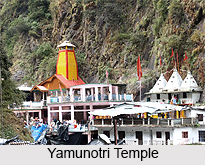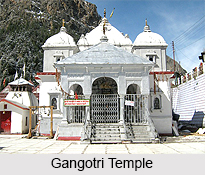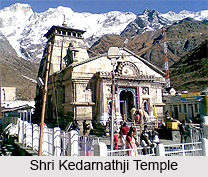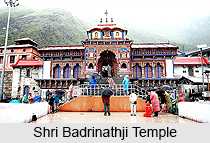 Char Dham Yatra is revered as one of the most significant and religious pilgrimages by the Hindus, covering the four holy places in the mountainous state of Uttarakhand in India - Yamunotri, Gangotri, Kedarnath and Badrinath. Char Dham literally means four abodes. Char Dham Yatra is not to be confused with the Char Dham, which refers to the bigger circuit of four holiest places revered by Hindus spread in all four corners of the nation - Badrinath, Puri, Rameswaram and Dwarka. The Char Dham Yatra relates to the smaller circuit, though regarded with equal reverence and importance since the mid 20th century as the bigger one, situated in the Garhwal division of Uttarakhand. This region is called the `Devabhoomi` (literally land of the God). In the Hindu Shastras, they are referred to as Kedarkhand. These four holy abodes include representatives from all three major Hindu sectarian traditions, with two Shakta (Goddesses Yamuna and Ganga) sites (Yamunotri and Gangotri), one Shaiva (Lord Shiva) site (Kedarnath) and one Vaishnava (Lord Vishnu) site (Badrinath). The tradition of covering the Char Dham Yatra is in the following order:
Char Dham Yatra is revered as one of the most significant and religious pilgrimages by the Hindus, covering the four holy places in the mountainous state of Uttarakhand in India - Yamunotri, Gangotri, Kedarnath and Badrinath. Char Dham literally means four abodes. Char Dham Yatra is not to be confused with the Char Dham, which refers to the bigger circuit of four holiest places revered by Hindus spread in all four corners of the nation - Badrinath, Puri, Rameswaram and Dwarka. The Char Dham Yatra relates to the smaller circuit, though regarded with equal reverence and importance since the mid 20th century as the bigger one, situated in the Garhwal division of Uttarakhand. This region is called the `Devabhoomi` (literally land of the God). In the Hindu Shastras, they are referred to as Kedarkhand. These four holy abodes include representatives from all three major Hindu sectarian traditions, with two Shakta (Goddesses Yamuna and Ganga) sites (Yamunotri and Gangotri), one Shaiva (Lord Shiva) site (Kedarnath) and one Vaishnava (Lord Vishnu) site (Badrinath). The tradition of covering the Char Dham Yatra is in the following order:
•Yamunotri, the source of the Yamuna River and the abode of the Goddess Yamuna.
•Gangotri, the source of the Ganga River and abode of the Goddess Ganga.
•Kedarnath, where Hindu God Shiva is venerated as one of the 12 Jyotirlingas (12 holiest shrines of Shiva).
•Badrinath, the abode of Hindu God Vishnu in his aspect of Badrinarayan.
 The access points to these places are Rishikesh, Haridwar and Dehradun. It is customary to go to Rameswaram and collect some sand at the beach at Setu, to immerse in the holy Ganga River before setting out for the Char Dham Yatra. The pilgrims bathe in the holy waters of the Ganges, after completing the Char Dham Yatra.
The access points to these places are Rishikesh, Haridwar and Dehradun. It is customary to go to Rameswaram and collect some sand at the beach at Setu, to immerse in the holy Ganga River before setting out for the Char Dham Yatra. The pilgrims bathe in the holy waters of the Ganges, after completing the Char Dham Yatra.
Yamunotri Temple, Char Dham Yatra
Located in Uttarkashi at an elevation of 3,164 metres above sea level, Yamunotri Dham temple sanctifies thousands of spirits thronging to the place where River Yamuna originates. It is the only place where the pilgrims can find a blend of warm and cold environments, the Himalayan environment being purified and frozen with the cold tides of the glaciers of River Yamuna and the sides remaining warmed up with the thermal springs known as "kunds" of Goddess Shakti. A visit to Yamunotri temple, devoted to Goddess Yamuna, is a full day tour from Uttarakhand"s main towns of Rishikesh, Haridwar or Dehradun. The temple is accessible by a 13 kilometre trek from the town of Hanuman Chatti and 6 kilometre walks from Janki Chatt. In the Bhagavad Gita, Lord Krishna pronounces, "Out of all immovable things, I am the greatest mountain in the world, Himalayas." Lord Shiva resides in the Himalayas at Mount Kailash and his wife Parvati is referred to as Himavati, revered as the daughter of Himalaya. There are seven holy rivers in the Himalayas, together called the Sapta Samudrik Tirtha. These include Alakananda, Dhauli Ganga, Nandakini, Bhagirathi River, Pinder Ganga, Mandakini and Nayar. They are all said to have come down from Lord Shiva`s head, but they fall on different places near Yamunotri.
Gangotri Temple, Char Dham Yatra
The holy river Ganga originates from Gangotri that lies at an altitude of about 3,200 metres above mean sea level. The Ganges is believed to be the sacred source of purity and sanctity and thus, before visiting the Gangotri temple, devotees take a holy dip in the river. The Gangotri shrine is said to belong to the 18th century, an exquisite 20 feet structure made of white granite.
Kedarnath Temple, Char Dham Yatra
Shri Kedarnath Temple in the Rudraprayag district of Uttarakhand is elevated at an altitude of 3,584 metres above sea level, flanking around the river Mandakini that originates in the region. It is considered as one of the most pious abodes of Lord Shiva, believed to be one of the 12 holiest manifestations of Lord Shiva in the shape of "Jyotirlingas" (12 Jyotirlingas). The temple was established by Adi Shankaracharya and was privileged by the name of King Kedar, the ruler of Satya Yuga.
Badrinath Temple, Char Dham Yatra
Shri Badrinath Temple is elevated at an altitude of 3,415 metres above sea level in the Garhwal Hills on the banks of the Alaknanada River, originating in this region. Devoted to Lord Vishnu, legend has it that He meditated at this place for thousand incessant years under the Badri tree, hence the name Badrinath. The idol is made of the Shaligram statue in the meditative pose. It is the one of the most important site for the Vaishnavites. Believed to be established by Adi Shankaracharya in the 9th century, the temple is accessible from Haridwar, Rishikesh and Kotdwar.
There are five confluences together referred to as "Prayags", of the tributaries of the Ganges en route to Badrinath. A confluence is considered a significantly auspicious place. The main branch of the Ganges is the Bhagirathi that originates at Gaumukh, 18 kilometres east of Gangotri. The five confluences are located on the route between Rishikesh and Badrinath and many pilgrims bathe at all the five `sangams` (confluences) before visiting and paying homage at Badrinath.
 Devaprayag is the most significant confluence among these, of the Bhagirathi and Alakananda rivers. It is distant 90 kilometres from Rishikesh and at this point the river takes the name Ganges. It is the second most important confluence in India, next to Prayag in Allahabad, where the Yamuna, Ganges and Saraswati rivers meet.
Devaprayag is the most significant confluence among these, of the Bhagirathi and Alakananda rivers. It is distant 90 kilometres from Rishikesh and at this point the river takes the name Ganges. It is the second most important confluence in India, next to Prayag in Allahabad, where the Yamuna, Ganges and Saraswati rivers meet.
The Char Dham Yatra today is taken by thousands of devotees in an average pilgrimage season lasting from around mid April until Diwali (sometime in November). The peak season is the 2-month period before the monsoons, which normally arrives in late July. After the rains begin, travelling to the sites gets extremely dangerous, though safety is a major concern all throughout because of the extensive road construction and heavy traffic that have critically destabilized the rocks, causing fatal landslides and bus and jeep accidents an unpredictable regular occurrence. Mortality rate in a season often surpasses 200. Some pilgrims also visit the sites after the monsoons and before they become blocked by snow. Although temperatures at the shrines in the early winter months of October and November are inhospitable, it is said that the mountain scenery surrounding the sites is most vivid and spectacular, after the rains have had a chance to moisten the dust of the plains below. The sites of the Char Dham Yatra were washed away in the 2012 Himalayan flash floods, and most severely in June 2013, when the floods heavily devastated many parts of the Char Dham, particularly the town of Kedarnath that was almost destroyed with only the Kedarnathji Temple and a few buildings around remaining intact, though partially submerged by rocks and slurry.
After remaining suspended post the 2013 floods, the annual Char Dham Yatra restarted in May 2014. The footfall has increased since then with proactive measures taken up by the Uttarakhand government, who complete the pilgrimage with a belief to be relieved of all their sins and attain "moksha".



















